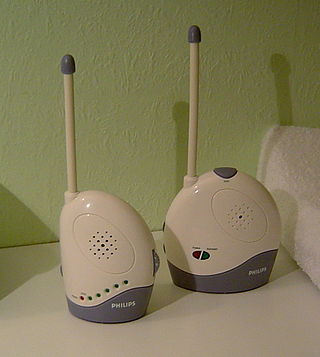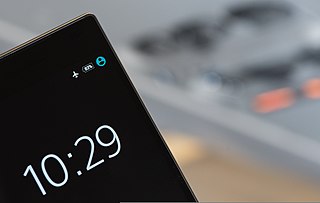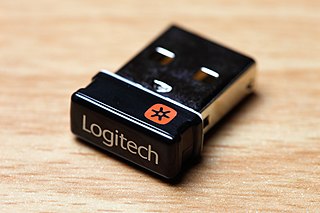
Bluetooth is a short-range wireless technology standard that is used for exchanging data between fixed and mobile devices over short distances and building personal area networks (PANs). In the most widely used mode, transmission power is limited to 2.5 milliwatts, giving it a very short range of up to 10 metres (33 ft). It employs UHF radio waves in the ISM bands, from 2.402 GHz to 2.48 GHz. It is mainly used as an alternative to wired connections to exchange files between nearby portable devices and connect cell phones and music players with wireless headphones.

A personal digital assistant (PDA), also known as a handheld PC, is a multi-purpose mobile device which functions as a personal information manager. PDAs have been mostly displaced by the widespread adoption of highly capable smartphones, in particular those based on iOS and Android, and thus saw a rapid decline in use after 2007.

Wireless communication is the transfer of information (telecommunication) between two or more points without the use of an electrical conductor, optical fiber or other continuous guided medium for the transfer. The most common wireless technologies use radio waves. With radio waves, intended distances can be short, such as a few meters for Bluetooth or as far as millions of kilometers for deep-space radio communications. It encompasses various types of fixed, mobile, and portable applications, including two-way radios, cellular telephones, personal digital assistants (PDAs), and wireless networking. Other examples of applications of radio wireless technology include GPS units, garage door openers, wireless computer mouse, keyboards and headsets, headphones, radio receivers, satellite television, broadcast television and cordless telephones. Somewhat less common methods of achieving wireless communications involve other electromagnetic phenomena, such as light and magnetic or electric fields, or the use of sound.

A touchpad or trackpad is a type of pointing device. Its largest component is a tactile sensor: an electronic device with a flat surface, that detects the motion and position of a user's fingers, and translates them to a position on a screen, to control a pointer in a graphical user interface. Touchpads are common on laptop computers, contrasted with desktop computers, where mice are more prevalent. Trackpads are sometimes used on desktops, where desk space is scarce. Because trackpads can be made small, they can be found on personal digital assistants (PDAs) and some portable media players. Wireless touchpads are also available, as detached accessories.

A baby monitor, also known as a baby alarm, is a radio system used to remotely listen to sounds made by an infant. An audio monitor consists of a transmitter unit, equipped with a microphone, placed near to the child. It transmits the sounds by radio waves to a receiver unit with a speaker carried by, or near to, the person caring for the infant. Some baby monitors provide two-way communication which allows the parent to speak back to the baby. Some allow music to be played to the child. A monitor with a video camera and receiver is often called a baby cam.
Archos is a French multinational electronics company that was established in 1988 by Henri Crohas. Archos manufactures tablets, smartphones, portable media players and portable data storage devices. The name is an anagram of Crohas' last name. Also, in Greek (-αρχος), it's a suffix used in nouns indicating a person with power. The company's slogan has been updated from "Think Smaller" to "On The Go", and the current "Entertainment your way".

A tablet computer, commonly shortened to tablet, is a mobile device, typically with a mobile operating system and touchscreen display processing circuitry, and a rechargeable battery in a single, thin and flat package. Tablets, being computers, have similar capabilities, but lack some input/output (I/O) abilities that others have. Modern tablets largely resemble modern smartphones, the only differences being that tablets are relatively larger than smartphones, with screens 7 inches (18 cm) or larger, measured diagonally, and may not support access to a cellular network. Unlike laptops, tablets usually run mobile operating systems, alongside smartphones.

A projection keyboard is a form of computer input device whereby the image of a virtual keyboard is projected onto a surface: when a user touches the surface covered by an image of a key, the device records the corresponding keystroke. Some connect to Bluetooth devices, including many of the latest smartphone, tablet, and mini-PC devices with Android, iOS or Windows operating system.

The Nike+iPod Sports Kit is an activity tracker device, developed by Nike, Inc., which measures and records the distance and pace of a walk or run. The Nike+iPod consists of a small transmitter device attached to or embedded in a shoe, which communicates with either the Nike+ Sportband, a receiver plugged into an iPod Nano. It can also work directly with a 2nd Generation iPod Touch, iPhone 3GS, iPhone 4, iPhone 4S, iPhone 5, The Nike+iPod was announced on May 23, 2006. On September 7, 2010, Nike released the Nike+ Running App on the App Store, which used a tracking engine powered by MotionX that does not require the separate shoe sensor or pedometer. This application works using the accelerometer and GPS of the iPhone and the accelerometer of the iPod Touch, which does not have a GPS chip. Nike+Running is compatible with the iPhone 6 and iPhone 6 Plus down to iPhone 3GS and iPod touch. On June 21, 2012, Nike released Nike+ Running App for Android. The current app is compatible with all Android phones running 4.0.3 and up.

Pen computing refers to any computer user-interface using a pen or stylus and tablet, over input devices such as a keyboard or a mouse.

Radio is the technology of communicating using radio waves. Radio waves are electromagnetic waves of frequency between 3 hertz (Hz) and 300 gigahertz (GHz). They are generated by an electronic device called a transmitter connected to an antenna which radiates the waves. They are received by another antenna connected to a radio receiver. In addition to communication, radio is used for radar, radio navigation, remote control, remote sensing, and other applications.

Wireless speakers are loudspeakers that receive audio signals using radio frequency (RF) waves rather than over audio cables. The two most popular RF frequencies that support audio transmission to wireless loudspeakers include a variation of WiFi IEEE 802.11, while others depend on Bluetooth to transmit audio data to the receiving speaker.

Airplane mode is a setting available on smartphones and other portable devices. When activated, this mode suspends the device's radio-frequency (RF) signal transmission technologies, effectively disabling all analog voice, and digital data services, when implemented correctly by the electronic device software author.
Bluetooth Low Energy is a wireless personal area network technology designed and marketed by the Bluetooth Special Interest Group aimed at novel applications in the healthcare, fitness, beacons, security, and home entertainment industries. Compared to Classic Bluetooth, Bluetooth Low Energy is intended to provide considerably reduced power consumption and cost while maintaining a similar communication range.
The history of tablet computers and the associated special operating software is an example of pen computing technology, and thus the development of tablets has deep historical roots. The first patent for a system that recognized handwritten characters by analyzing the handwriting motion was granted in 1914. The first publicly demonstrated system using a tablet and handwriting recognition instead of a keyboard for working with a modern digital computer dates to 1956.

The HP TouchPad is a tablet computer that was developed and designed by Hewlett-Packard. The HP TouchPad was launched on July 1, 2011, in the United States; July 15 in Canada, United Kingdom, France, Germany; and August 15 in Australia.

The Logitech Unifying Receiver is a small dedicated USB wireless receiver, based on the nRF24L-family of RF devices, that allows up to six compatible Logitech human interface devices to be linked to the same computer using 2.4 GHz band radio communication. Receivers that are bundled with a Logitech product are paired with the device at the factory. When purchasing a replacement receiver or connecting multiple devices to one receiver, pairing requires the free-of-charge Logitech Unifying software, available for Microsoft Windows and Mac OS X. On Linux the Solaar software can be used to adjust the configurations. Although not compatible with Bluetooth, devices pair to Unifying Receivers in a similar way. Peripherals remain paired, and can then be used on systems not supporting the software. Logitech receivers compatible with the Unifying protocol can be identified by the orange Unifying logo, which distinguishes them from Logitech Nano receivers of similar appearance, which pair in a similar manner but only with a single device, without using the Unifying protocol.

Typeeto is a software that allows users to use a Bluetooth-compatible Macintosh keyboard with a range of different devices, including iOS and Android smartphones and tablets, Apple TV, game consoles, Windows PCs, iPad, iPhone, iPod Touch, and MacBooks. The tool allows the keyboard to connect to multiple devices simultaneously, and users can switch between them using a designated hotkey.

The sixth-generation iPad Mini is a tablet computer in the iPad Mini line, designed, developed and marketed by Apple Inc. It was announced on September 14, 2021, and released on September 24, 2021, alongside the ninth-generation iPad, iPhone 13 and iPhone 13 Pro. Its predecessor, the fifth-generation iPad Mini, was discontinued on the same day. It is available in four colors: Space Gray, Starlight, Pink, and Purple.


















